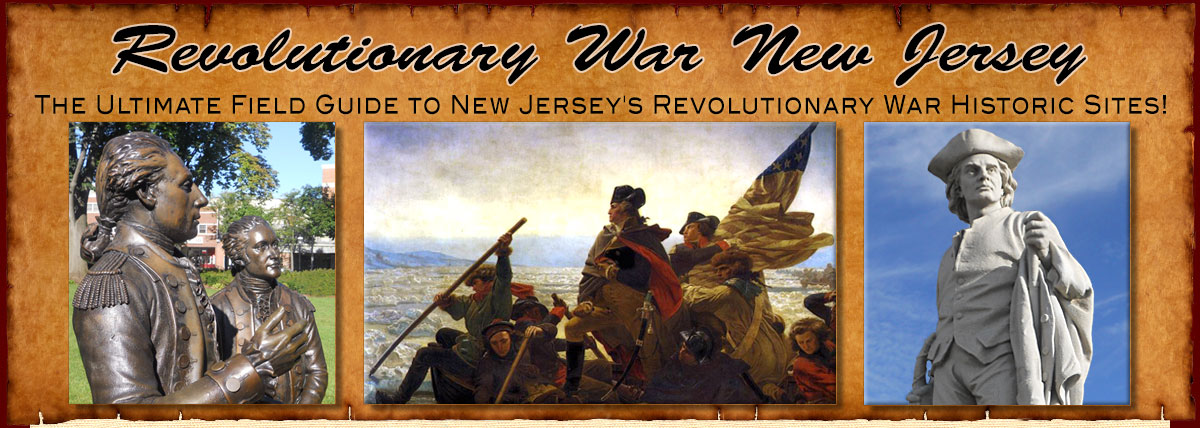

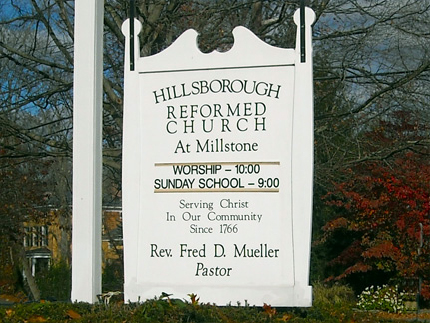
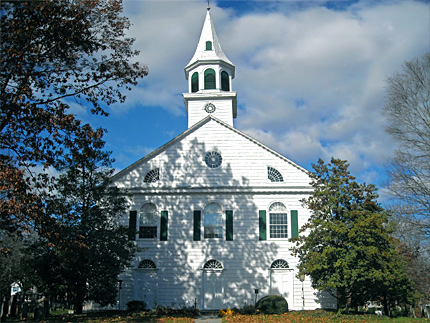
Hillsborough Reformed Church and Cemetery
1 Amwell Rd.
Map / Directions to the Hillsborough Reformed Church
Map / Directions to all
Millstone Revolutionary War Sites
June 14-19,1777 [1]
British Forces Occupy Millstone Area (Which was then part of Hillsborough, and also known as Somerset Courthouse)
In June 1777, General George Washington and the Continental (American) Army were encamped about ten miles northeast of here, behind the security of the Watchung Mountains, in what is known as the Middlebrook Encampment. As it did on numerous occasions during the war, the Watchung Mountains provided a layer of protection for the Continental Army. The height of the mountains also enabled them to observe activity to the east, including the thousands of British forces who had occupied New Brunswick since the previous December.
The British forces in New Brunswick greatly outnumbered the Continental Army troops at Middlebrook, but the protection of the Watchung Mountains made a British attack on the Continental Army impractical. With this in mind, the British General William Howe made an attempt to lure Washington's forces out of the mountains into the flatlands below, where his superior troop strength would give him the clear advantage.
On June 14, Howe moved thousands of troops west from New Brunswick to both sides of the Millstone River. Some encamped on the west side of the river in what is now Millstone, but was then part of Hillsborough. The rest were encamped on the east side of the river in Middlebush (in what is now Franklin Township).
Howe's intent was to fool Washington into thinking that he was going to move his forces farther west to make an attack on Philadelphia, which was then the American capital. If he could lure Washington's troops from the security of the Watchung Mountains into a fight on the flatlands, the British superior troop strength would give them the advantage.
The British remained here for several days while General Washington kept an eye on their activities from the Watchung Mountains. However, by June 19 it was apparent to Howe that Washington would not be lured down from the mountains at this time, and the British forces returned to New Brunswick, without having provoked a battle with the Continental Army.
Over the next several days, circumstances did bring some of Washington's forces down into the flatlands, and the Battle of the Short Hills was fought.
The original Hillsborough Church building that stood here was burned and heavily damaged during the British occupation in June 1777. It was repaired in 1779. During the war, it was used as a hospital by both the British and the Americans at different times. That original church building stood here until 1828, when it was replaced by the much larger church structure that is still here today. [2]
The church's cemetery contains the grave of Isaac Van Cleefe, who served as a corporal in the Somerset County Militia during the Revolutionary War. He died June 30, 1804, at age 61. [3]
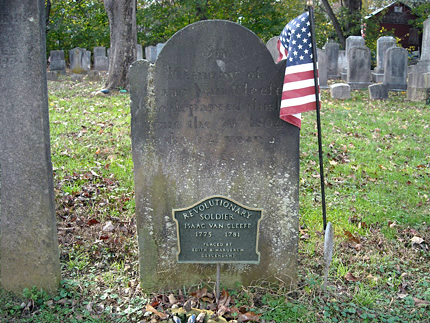
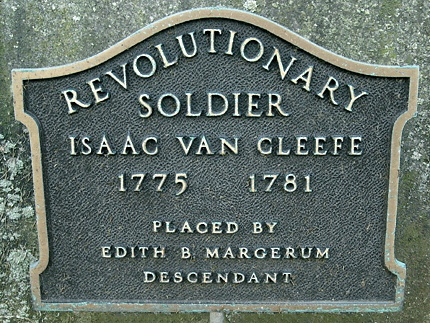

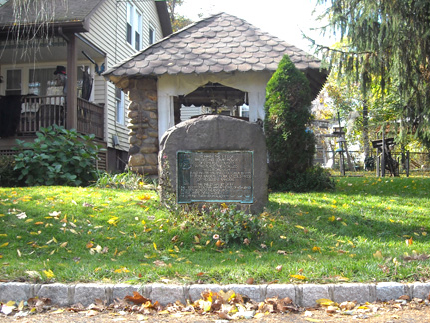
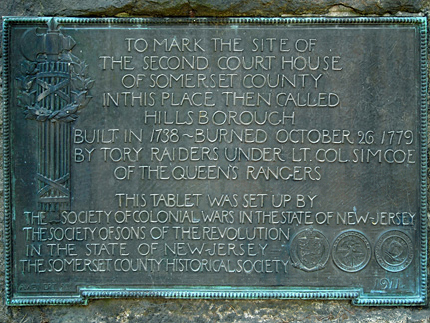
Burned Somerset County Courthouse Monument
13 South River St.
Map / Directions to the Burned Courthouse Site
Map / Directions to all Millstone Revolutionary War Sites
This monument sits on the property of a private residence.
Please respect the privacy and property of the owners.
In front of this house on South River St. is a boulder monument marking the site of the second Somerset County courthouse. Built in 1738, the courthouse was burned in October 1779 by a British raiding party under the command of Lt. Col. John Simcoe. [4]
A newspaper article that appeared several days later in The New York Gazette: and the Weekly Mercury gave the following account of the event, along with the capture of Simcoe by the Americans after the burning of the courthouse.
Note that New York City was occupied by the British for most of the war, including the time this article appeared, so the article is written from the pro-British point of view.
(Capitalization and spelling have been left uncorrected and unmodernized.)
"On Thursday Morning last, about 2 o'clock, the Queen's Rangers, with the Cavalry belonging to that Regiment, and ten Light-Horse, under the Command of Capt. Stewart, who are stationed on Staten-Island, landed at Amboy, and proceeded as far as Bonam-Town, when the Foot [soldiers] returned to Amboy, and the Cavalry, amounting to 70, commanded by Col. Simcoe, advanced to Bound-Brook, where they destroyed 18 large flat-bottomed Boats, and some Stores; they then proceeded to Somerset Court House, 28 Miles from Amboy, released the Loyalists confined, set Fire to it, and destroyed a large Quantity of Forage and Stores, collected for Mr. Washington's Army.
"On their Return on the South Side of the [Raritan River], within two Miles of Brunswick, in a Piece of Woods they were fired upon by a large body of Rebels, who lay in Ambush; the Cavalry immediately charged and dispersed the Rebels, — but Col. Simcoe having in the Charge his Horse shot under him, in the Fall received a Bruise, which stunned him, and his gallant Party thinking him killed, left him on the Field, approached to Brunswick on the Hill near the Barracks, they discovered 170 Rebels drawn up to receive them; these were also immediately charged and defeated, with great Slaughter. Among the killed we are informed, was a Rebel Major, named Edgar, a Captain Voorhies, and another Captain besides many other Officers. — The Party then proceeded on the Road towards South-Amboy, and several Miles from Brunswick they joined the Foot, who had passed over to South-Amboy. In this Excursion near thirty Prisoners were taken; The whole Loss sustained by this Enterprize, is one Man killed and 4 taken besides the brave Colonel Simcoe who we hear is now a Prisoner at Brunswick." [5]

1. ^ See the following contemporary sources regarding the events of June 14 - 19, 1777
• John André, Major André's Journal (Tarrytown, New York: William Abbatt, 1930) pages 25-29
Available to be read at the Hathi Trust Digital Library website here• Captain Johann Ewald, Translated and edited by Joseph P. Tustin, Diary of the American War - A Hessian Journal (New Haven and London: Yale University Press, 1979) page 64-67
▸ Page 67 shows a map of Hillsborough which is "believed to be the only contemporary map extant showing a part of General Howe's unsuccessful maneuver to lure Washington out of his strong positions into open warfare."
▸ ▸ Images of this map can be seen on the Bloomsburg University of Pennsylvania website here• "Road from Brunswick thro' Somerset to Van Vacter's Bridge. No 74, F" 1779 Map by Robert Erskine.
▸ Has a spot marked as Howe's 1777 headquarters in Middlebush (Franklin Township), near the property of Garrett Vorhees
▸ ▸ An image of this map can be seen on the NYU Digital Library Technology Services website here
• “General Orders, 14 June 1777,” Founders Online, National Archives (http://founders.archives.gov/documents/Washington/03-10-02-0029 [last update: 2015-12-30]). Source: The Papers of George Washington, Revolutionary War Series, vol. 10, 11 June 1777 – 18 August 1777, ed. Frank E. Grizzard, Jr. Charlottesville: University Press of Virginia, 2000, p. 33.
• “From George Washington to John Hancock, 14 June 1777,” Founders Online, National Archives (http://founders.archives.gov/documents/Washington/03-10-02-0032 [last update: 2015-12-30]). Source: The Papers of George Washington, Revolutionary War Series, vol. 10, 11 June 1777 – 18 August 1777, ed. Frank E. Grizzard, Jr. Charlottesville: University Press of Virginia, 2000, pp. 36–37.
• “From George Washington to Major General John Sullivan, 14 June 1777,” Founders Online, National Archives (http://founders.archives.gov/documents/Washington/03-10-02-0037 [last update: 2015-12-30]). Source: The Papers of George Washington, Revolutionary War Series, vol. 10, 11 June 1777 – 18 August 1777, ed. Frank E. Grizzard, Jr. Charlottesville: University Press of Virginia, 2000, pp. 40–41.
• “From George Washington to Major General John Sullivan, 14 June 1777,” Founders Online, National Archives (http://founders.archives.gov/documents/Washington/03-10-02-0039 [last update: 2015-12-30]). Source: The Papers of George Washington, Revolutionary War Series, vol. 10, 11 June 1777 – 18 August 1777, ed. Frank E. Grizzard, Jr. Charlottesville: University Press of Virginia, 2000, p. 41.
• “From George Washington to Major General Philip Schuyler, 16 June 1777,” Founders Online, National Archives (http://founders.archives.gov/documents/Washington/03-10-02-0055 [last update: 2015-12-30]). Source: The Papers of George Washington, Revolutionary War Series, vol. 10, 11 June 1777 – 18 August 1777, ed. Frank E. Grizzard, Jr. Charlottesville: University Press of Virginia, 2000, pp. 53–54.
• “From George Washington to Major General Benedict Arnold, 17 June 1777,” Founders Online, National Archives (http://founders.archives.gov/documents/Washington/03-10-02-0058 [last update: 2015-12-30]). Source: The Papers of George Washington, Revolutionary War Series, vol. 10, 11 June 1777 – 18 August 1777, ed. Frank E. Grizzard, Jr. Charlottesville: University Press of Virginia, 2000, pp. 58–61.
• “From George Washington to Major General Israel Putnam, 17 June 1777,” Founders Online, National Archives (http://founders.archives.gov/documents/Washington/03-10-02-0061 [last update: 2015-12-30]). Source: The Papers of George Washington, Revolutionary War Series, vol. 10, 11 June 1777 – 18 August 1777, ed. Frank E. Grizzard, Jr. Charlottesville: University Press of Virginia, 2000, pp. 62–63.
• “From George Washington to Brigadier Generals John Glover and Alexander McDougall, 20 June 1777,” Founders Online, National Archives (http://founders.archives.gov/documents/Washington/03-10-02-0083 [last update: 2015-12-30]). Source: The Papers of George Washington, Revolutionary War Series, vol. 10, 11 June 1777 – 18 August 1777, ed. Frank E. Grizzard, Jr. Charlottesville: University Press of Virginia, 2000, pp. 83–84.
• “From George Washington to John Hancock, 20 June 1777,” Founders Online, National Archives (http://founders.archives.gov/documents/Washington/03-10-02-0084 [last update: 2015-12-30]). Source: The Papers of George Washington, Revolutionary War Series, vol. 10, 11 June 1777 – 18 August 1777, ed. Frank E. Grizzard, Jr. Charlottesville: University Press of Virginia, 2000, pp. 84–86.
• For more information and accompanying source notes about the Battle of the Short Hills, see the Battle of the Short Hills Monument entry on the Scotch Plains page.
2. ^ Hillsborough Reformed Church at Millstone website
3. ^ Information drawn from:
• Gravestone and markers in the cemetery
• William S. Stryker, Official Register of the Officers and Men of New Jersey in the Revolutionary War (Trenton: Wm. T. Nicholson & Co., 1872) pages 478
Available to be read at Google Books here
4. ^ The plaque on the boulder states, "Tablet was set up by the Society of Colonial Wars in the State of New Jersey, The Society of Sons of the Revolution in the State of New Jersey, The Somerset County Historical Society, 1911"
• There is some disagreement as to the specific date of the burning. The boulder plaque gives the date as October 26. Some books state it was October 27.
However, the article from The New York Gazette: and the Weekly Mercury quoted in the entry is dated October 30 and appeared in the newspaper on November 1st. The article states that the events described occurred "On Thursday Morning last." In 1779, Thursday fell on October 28th, not the 26th or 27th.
5. ^ The New York Gazette: and the Weekly Mercury, No. 1463, November 1, 1779, as reprinted in:
William Nelson, Editor, Archives of the State of New Jersey, Second Series, Vol III (Documents Relating to the Revolutionary History of the State of New Jersey / Extracts from American Newspapers relating to New Jersey) (Trenton: John L. Murphy Publishing Company, 1906) p.719-720
Available to be read at Google Books here